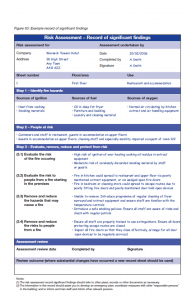This week we’re going to guide you through a little more detail on keeping good fire safety records.
In last week’s blog we talked you through the process of performing a fire risk assessment in a building with sleeping accommodation. Fire safety records play an important part in keeping on top of what’s going on in the building and could save you time in the long run. They are also there as evidence of your fire safety strategy should the authorities want to come and review them.
Whilst there are guidelines on how to perform fire risk assessments, and examples of the type of information you need to record, there is no prescribed format of how you should keep fire safety records. The regulations simply state that you should keep them. Bear in mind, though, that the quality of your fire safety records will probably reflect on the quality of your fire safety!
Here are a few guidelines on how to maintain good fire safety records:
- Keep the fire safety records in a specified place on the premises and ensure that relevant personnel know where it is kept
- Maintain records of any significant findings (as part of your fire risk assessment) and any action you’ve undertaken to rectify them
- Include tests you’ve undertaken of escape routes, detailing the route, fire exit signage along the way and final exit doors.
- Make a note of fire alarm tests you’ve undertaken. Remember, regulations require you to perform a weekly alarm test, so keep a register of those tests and of any issues arising as a result of them.
- Record maintenance and tests of relevant equipment, including fire alarms, fire extinguishers, fire hoses/reels, emergency lighting, smoke detectors and fire suppression systems.
- Training of relevant personnel should be recorded (for example fire extinguisher training)
- Perform a regular evacuation test and record how long it took to get everyone out of the building, and to account for everyone on the list. Remember to include records of any visitors or workmen on site at the time.
- Where you have trained relevant people, maintain records of their qualifications and levels of competence, especially relating to them carrying out inspections and tests. This also relates to any outsourced supplier you use – ensure you record their qualifications & experience as part of the process. It all helps to demonstrate you take your obligations seriously.
- Make a special effort to record any incidents which could have started a fire (but didn’t) and what you are going to do to prevent it from happening again.
- Record high risk areas and note down how you plan to reduce the risk of a fire breaking out.
There is so much useful information available to you about how to maintain good fire safety records and undertake your legal obligations with regard to fire risk assessments.

